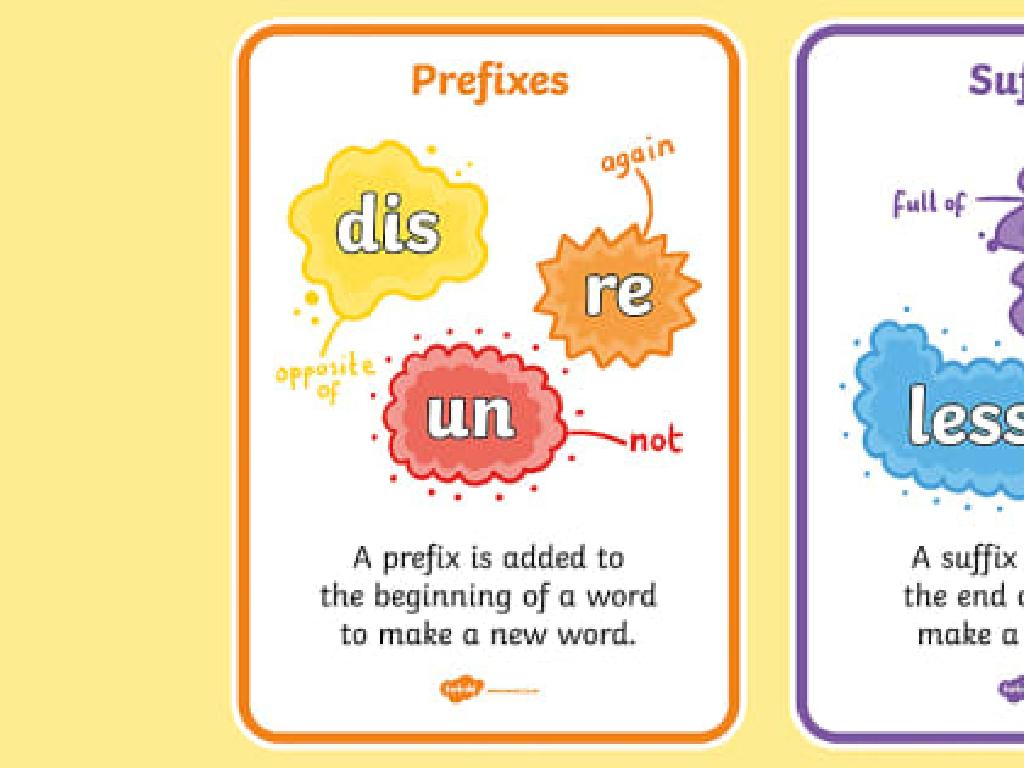Interpret Stem-And-Leaf Plots
Subject: Math
Grade: Sixth grade
Topic: Data And Graphs
Please LOG IN to download the presentation. Access is available to registered users only.
View More Content
Interpreting Stem-and-Leaf Plots
– What is a stem-and-leaf plot?
– A type of graph to organize numbers, like scores or measurements
– Interpreting data with stem-and-leaf
– Each number is split into a stem (first digit/s) and a leaf (last digit)
– Advantages of stem-and-leaf plots
– They show data in an organized way, making it easy to compare
– Practical examples of usage
– Use in daily life: tracking temperatures, class test scores, etc.
|
This slide introduces stem-and-leaf plots, a key concept in understanding data representation. Begin by explaining the structure of a stem-and-leaf plot, emphasizing how numbers are divided into stems and leaves. Highlight the ease of interpreting data through this method, as it allows for quick comparison and identification of data trends. Discuss the benefits of using stem-and-leaf plots over other types of graphs, such as the clear display of data distribution and the ability to retain the original data values. Provide relatable examples to help students visualize how these plots are used in real-world scenarios, such as in meteorology or in the classroom to track test scores. Encourage students to think of other areas where this type of data organization might be helpful.
Understanding Stem-and-Leaf Plots
– Define stem-and-leaf plot
– A type of graph to organize numbers, showing frequency
– Identify parts of the plot
– Stem: the leading digit(s), Leaf: the last digit, Key: explains the units
– Compare with other graphs
– Unlike bar graphs, it retains original data and shows distribution
– Interpretation and key usage
– Use the key to read values; e.g., 5 | 2 means 52 if key says 1 | 2 = 12
|
This slide introduces students to stem-and-leaf plots, a graphical representation that helps to organize and display numerical data. The stem represents the initial digits of each number, while the leaves show the last digit. A key is used to interpret the values. It’s important to highlight how this type of plot differs from bar graphs and histograms, as it shows the actual numbers in the data set, allowing for a more detailed understanding of the distribution. Encourage students to practice creating and interpreting these plots with real data sets to grasp the concept fully.
Creating a Simple Stem-and-Leaf Plot
– Collect your data set
– Define the stem and leaf
– Stems are leading digits, leaves are trailing digits
– Sort data into the plot
– List stems in a column, attach leaves for each stem
– See an example with real data
– Example: Data set 12, 15, 11 becomes stem 1, leaves 2, 5, 1
|
This slide introduces students to the process of creating a stem-and-leaf plot, a type of graph used to organize and display numerical data. Start by gathering a set of numbers. Then, determine the ‘stem’ (usually the largest common place value of the data set) and the ‘leaf’ (the next significant digit). Organize the data by listing the stems in a vertical line and attaching the corresponding leaves to the appropriate stem. Use a small data set as an example to illustrate the process. This visual representation helps students quickly see the distribution of data and is a foundational skill in understanding more complex statistical concepts.
Reading a Stem-and-Leaf Plot
– Identify stems and leaves
– Stems are the first digits, leaves are the last digit of numbers
– Learn to read the values
– Combine stem and leaf to form original numbers
– Use the key for comprehension
– Key explains how to interpret stems and leaves
– Practice with an example
– Example: Stem 5, leaf 8 represents 58
|
This slide introduces students to the basics of interpreting stem-and-leaf plots. Start by explaining that the ‘stem’ represents the initial digit(s) of the numbers in the data set, while the ‘leaf’ represents the last digit. Show students how to combine stems and leaves to reconstruct the original numbers. Emphasize the importance of the key, which provides the scale for interpreting the plot. For instance, a key of 1|2 = 12 indicates that the stem represents tens and the leaf represents ones. Provide a simple example, such as a plot showing ages of students in a class, and walk through the process of reading the plot together. Encourage students to practice with additional examples to solidify their understanding.
Interpreting Stem-and-Leaf Plots
– Find the data range
– Range is the difference between the highest and lowest values
– Determine median and mode
– Median: the middle value. Mode: the most frequent value
– Compare data sets
– Use plots to view multiple data sets side by side
– Understand plot benefits
|
This slide aims to teach students how to interpret data from stem-and-leaf plots. Start by explaining how to find the range of the data, which gives insights into data spread. Then, move on to finding the median, which is the middle value when the data is ordered, and the mode, which is the most frequently occurring value. Emphasize the importance of these measures in understanding the data set. Next, show how to compare different data sets by placing their stem-and-leaf plots side by side, making it easier to compare distributions and central tendencies. Highlight how stem-and-leaf plots provide a clear visual representation of data, allowing for quick analysis and comparison.
Real-World Applications of Stem-and-Leaf Plots
– Analyzing sports statistics
– Track players’ scores or times
– Comparing classroom test scores
– Visualize the range of class performance
– Recording weather data
– Observe temperature or rainfall patterns
– Understanding data distribution
|
This slide aims to show students how stem-and-leaf plots are used in various real-world scenarios to organize and interpret data. For sports, they can help track and compare players’ scores or times. In the classroom, these plots can be used to compare test scores, providing a visual representation of how the class performed as a whole. Weather data, such as temperature or rainfall, can also be recorded using stem-and-leaf plots, helping to identify patterns over time. Encourage students to think of other areas where data is collected and how these plots could be useful. The goal is to help students recognize the practical applications of stem-and-leaf plots in everyday life and the importance of understanding data distribution.
Class Activity: Crafting Stem-and-Leaf Plots
– Collect class data together
– Each student designs a plot
– Use the collected data to form your own stem-and-leaf plot
– Share plots with the class
– Discuss everyone’s findings
– Compare different plots to see variations in data representation
|
This interactive class activity is aimed at helping students understand how to create and interpret stem-and-leaf plots. Start by collecting data as a class; this could be the number of pets each student has, their shoe sizes, or the number of books read this month. Once the data is collected, guide each student through creating their own stem-and-leaf plot using the data. After everyone has created their plot, have students share their work with the class. This will allow students to see how the same data can be represented in different ways and understand the importance of accurate data representation. Encourage discussion about what the plots reveal about the data. Possible variations for individual student activities could include using different data sets, comparing two related data sets, or finding the mean, median, and mode from their plots.
Wrapping Up: Stem-and-Leaf Plots
– Recap: Creating stem-and-leaf plots
– Recap: Interpreting stem-and-leaf plots
– Data organization significance
– Organized data helps in understanding and analyzing information effectively.
– Homework: Craft your own plot
– Find any data set, like test scores, and make a stem-and-leaf plot.
|
As we conclude today’s lesson, remember that stem-and-leaf plots are a valuable tool for organizing numerical data in an orderly fashion, making it easier to interpret and analyze. They allow us to see the distribution of data and identify patterns or outliers quickly. For homework, students are expected to find a set of data, which could be anything from daily temperatures to sports scores, and create their own stem-and-leaf plot. This will reinforce their understanding of the concept and give them practical experience in organizing and analyzing data. In the next class, we will review the homework, discuss any challenges faced, and celebrate successful data organization!






